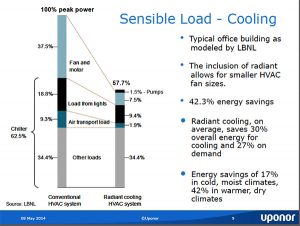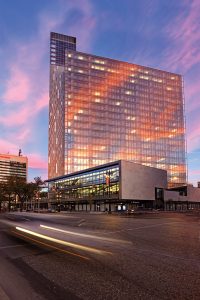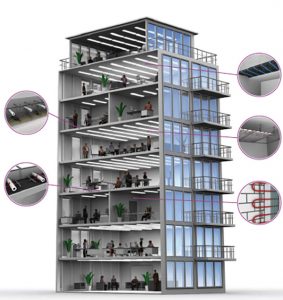
Radiant cooling: Emerging technology shows promise
May 16, 2017 | By Rob Waters
Most heating professions are very familiar with the principals of radiant floor heating systems and how they work. These systems have become an accepted part of the HVAC offering of many engineers and contractors, as they have proven to offer customers comfortable, efficient, healthy and quiet heating systems. Ask many of those same engineers and contractors about radiant cooling systems and you will probably get a mix of confusion, fear of the unknown and dismissal.
Cooling with radiant however, offers many of the same benefits as radiant heating; cooling systems that are comfortable, efficient and quiet. Radiant cooling systems have been widely used in Europe for some time and they are starting to become more popular in North America, especially in the dry climates of Southwest USA. According to Jerry Leyte, Central Canada sales manager for Uponor, there are now quite a few radiant cooling systems installed in Canada.
“There are radiant cooling systems installed in the Calgary and Winnipeg Airports, as well as the Toronto District School Board and Manitoba Hydro Place office that are performing exceptionally well,” notes Leyte. “Most applications for radiant cooling are in commercial applications such as airports, offices, schools, and large public areas such as museums. Residential applications are not very common, but can be installed if they are very carefully controlled,” adds Leyte.
Related: Small scale hydronic cooling
Radiant cooling follows the same principles as radiant heating, but in reverse. Thermal energy is exchanged by radiant heat transfer between the heat loads present in the space and the cool floor or ceiling. Energy radiates from the objects, people, equipment and lights to the cool surface, which is opposite to what happens in heating mode, where the heated panel radiates to the objects and people. It is possible to have radiant panels that provide both heating and cooling, providing the best comfort and efficiency all year long.
THE DESIGN
There are two broad types of radiant cooling systems, which are chilled slabs and radiant panels. Chilled slabs offer benefits of integration into the building, lower installed cost and increased thermal mass. Often referred to as thermally activated building systems (TABS), this large thermal mass can be advantageous for some applications, where the mass can be “charged up” during times of off-peak electrical rates. Radiant slabs can be arranged so that they are exposed on both sides, providing, at different times of the year, radiant heat to the space above and radiant cooling to the space below.
Radiant cooling slabs use similar design and sizing principles as a hydronic radiant floor system, using the same types of PEX pipes, manifolds and pumps as in heating. Chilled water between 55F to 58F is circulated through the pipes, which are embedded in either floor or ceiling. Radiant cooling slabs require a close tube spacing of six to nine inches on centre, which is a little tighter than the nine to 12-in. normally required for radiant heating.
Radiant cooling can also be delivered through specialized panels, which would typically be attached to ceilings, but can also be attached to walls. Panels offer installation flexibility in terms of where they can be placed and how they are integrated with dropped ceilings, lights and other electrical systems. The lower thermal mass of panels allows them to react very rapidly to changing loads. Radiant cooling panels are designed so that they can be retrofitted into the ceilings of older buildings as the plenum space requirement is minimal relative to fan coil units or VAV systems.
Radiant cooling from a slab can be delivered to a space from the floor or ceiling. Since radiant heating systems tend to be in the floor, the obvious choice would be to use the same piping for circulating cooled water. While this makes sense in some cases, delivering cooling from the ceiling has several advantages. It is easier to leave a ceiling exposed to the room below, which creates a better radiating surface to occupants and objects. As floors will often have coverings and furnishings, the effectiveness of the radiant cooling effect through the floor can be decreased. The ceiling will also come in contact with any rising warm air, creating greater convective heat exchange and a better cooling effect. Cooling delivered through the floor does make more sense when there is a high amount of solar gain directly onto the floor, because the cool floor can more easily remove those loads than the ceiling.
OVERCOMING CHALLENGES
One of the most common questions asked about radiant cooling is “How do you deal with humidity in the air and the potential for condensation on the slab?” This probably leads to the most angst and uncertainty with engineers thinking about water damage, mould and safety issues. While this is an extremely critical design issue, it is one that is easily overcome with good design and controls.
A radiant cooling system will not deal with any latent heat removal (moisture in the air), so this must be handled by incorporating a separate air handling system to remove the latent moisture load in the space. The air handling system will usually also be required to provide ventilation and air quality control. Careful control of the humidity level must be maintained at all times in a radiant cooling system, to ensure that the dew point of the air does not get lower than the surface temperature of the slab or panel.
Related: How to align expectations of hydronic systems with reality
Controls will most often include multiple sensors embedded in the slab and air humidity sensors in the air space. Condensation issues can be avoided completely by constantly monitoring and controlling both humidity levels and slab temperatures. Important design criteria to follow include keeping floor surface temperatures no less than 66F, and a having a room set point temperatures in the range of 76F to 78F. The cooling capacity of the radiant cooling system is limited to about 12-15 btu/h/ft2. The air handling system must handle the balance of the cooling load. When radiant cooling is used in areas where solar gain will directly contact the floor, then the cooling capacity can increase substantially up to 25-32 Btu/h/ft2. This makes radiant cooling in the floor very effective in buildings with large glass facades. Because the radiant cooling slab will handle the sensible load, the size of the air handling system is reduced substantially compared to a traditional cooling system. Smaller fans, ductwork and distribution systems results in significant installation savings, as well as reduced electrical operating costs. Smaller plenums can sometimes result in savings in building height, which makes architects happy.

Energy use comparison; conventional versus radiant (courtesy Lawrence Berkeley National Laboratory).
One of the best advantages that radiant cooling systems offer is the potential to lower energy consumption compared to conventional cooling systems. Research conducted by the Lawrence Berkeley National Laboratory in California, has shown significant energy savings potential for radiant cooling, with the amount depending on the climatic area. Their research has shown on average across the USA, savings are in the range of 30 per cent compared to conventional systems. Cool, humid regions might have savings of 17 per cent while hot, arid regions have savings of 42 per cent.
There are several reasons for reduced energy consumption, with much having to do with the benefits of hydronics in general, as well as the unique nature of radiant heat transfer. It is a much easier task to pump water than to blow air; to move the same amount of Btu’s the electrical consumption of a pump is much less than from a fan. Also the air handling component in a radiant cooling system is much smaller than conventional cooling systems, resulting in lower electrical energy consumption.
That large cool surface of a radiant cooling system provides a heat sink to draw heat away from our bodies. With the majority of heat being radiated away, there is a reduction in the amount that must be moved by convection. This allows people to feel comfortable at a higher air temperature set point. This, of course, converts into energy savings as well as better overall comfort. Another possibility for energy savings exists in high mass systems, where radiant cooling can shift some cooling to off-peak nighttime hours when electricity is cheaper.
Typically a radiant heating and cooling system will incorporate a condensing boiler for heating mode, and a chiller for cooling mode. A water-to-water geothermal heat pump with a reversing valve offers a natural synergy with radiant heating and cooling, as this device can provide both heating water in the winter and chilled water in the summer. Geothermal systems operate most efficiently when providing low heating water temperatures and moderate chilled water temperatures. This is precisely the range of operation that will be needed in a high mass radiant heating and cooling system, so the geothermal unit will operate at close to its maximum COP almost all year long.
Occupant comfort is another great benefit of radiant cooling systems. The large cool surface provides a heat sink to draw heat away from our bodies with a gentle cooling action creating a very comfortable, stable indoor climate. The volume of forced air flow is greatly reduced compared to convention air cooling systems. This reduces the potential for cold draughts, and also reduces dust and other allergens moving around. Radiant cooling systems operate very quietly, with a greatly reduces amount of noise from fans or blowers.
RISING TO THE OCCASION
Can radiant cooling be used for residential homes? According to Leyte, “it is possible to do, but there are certainly more challenges and a higher level of risk. With the possibility that doors and windows can be left open, the control of humidity can become very difficult.”
Another limitation for residential homes is that the use of carpet and pad would not be recommended for radiant cooling. For these reasons there is a very limited market in Canada for residential systems, coming primarily from “creative customers that are up for the challenge” according to Leyte. There are pockets, such as the southwest U.S., where the hot, dry climate offers the greatest advantage for radiant cooling with a large portion of cooling being the removing sensible heat, not latent. In these areas residential radiant cooling can work very effectively.
So while the market for residential radiant cooling may not develop in Canada, the commercial market does present some great promise. With building codes pushing to lower energy consumption in buildings, and a growing trend towards new green building technologies, radiant heating and cooling systems should continue to grow in popularity for many buildings. With benefits like high efficiency, high comfort levels, quiet and healthy operation, and building integration, there is a lot to like about radiant heating and cooling systems.
Robert Waters is president of Solar Water Services Inc., which provides training, education and support services to the hydronic industry. He is a mechanical engineering technologist graduate of Humber College and has over 30 years experience in hydronic and solar water heating. He can be reached at solwatservices@gmail.com.






